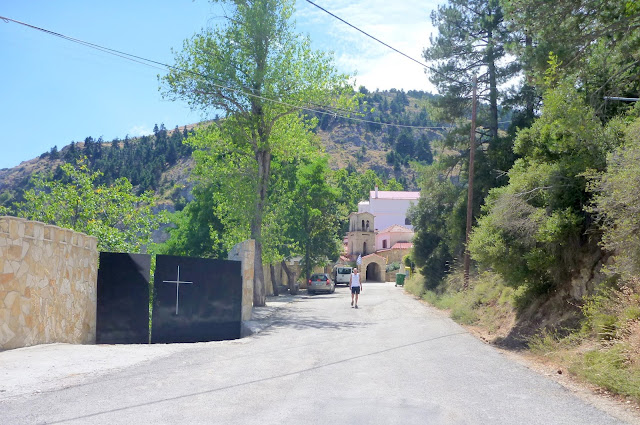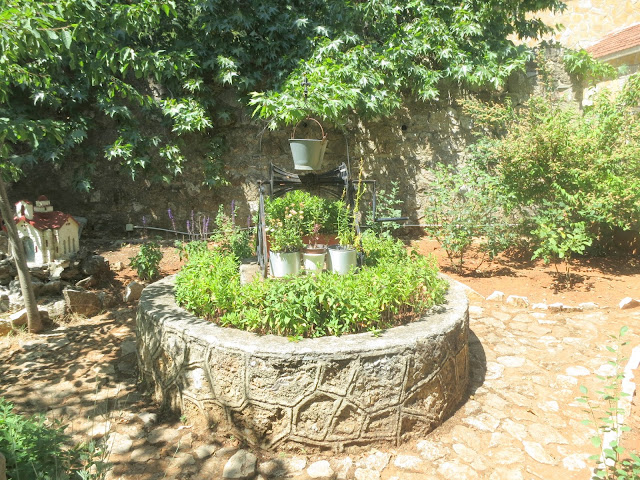The convent of St Vlasios near Ano Trikala, Korinthias.
The convent was closed to visitors the first time we tried to visit, so we came back the next day. Ken had seen the nuns tending to their gardens on his walks up the mountain and we really wanted to have a look around. It was well worth it, and in some ways it was one of the highlights of our visit to this region of Greece. I found the place very peaceful and calm, the nuns were very friendly and exuded an aura of contentment and tranquility - the whole place had this atmosphere of harmonious communal living, of being at peace with the world and it was furthermore, very beautiful. I was seduced.
The ubiquitous shrine outside the main gate.
The convent dates back to the 14th century when the icon of St Vlasios was discovered in a cave in the nearby mountains - about that later. The church was built during the 18th century. Originally it was a monastery and it played a significant role during the Ottoman occupation of Greece, not just in terms of providing refuge and support for the Greek people, but it also functioned as a krifo scholio, a secret school, where Greek language and literacy were taught to children at a time when those were forbidden by the Turks. In 1818 a branch of the Filiki Etaireia, the group that spearheaded the Greek revolution against the Turkish occupiers was formed here - again, more about that later.
looking back

Everything has been lovingly restored and is immaculately kept
with great attention to detail.
We walked through the entrance which on our second visit was open
through this arch
and entered one of the most beautiful gardens
the hydrangeas were stunning
as were all the flower beds and pots.
The bells and behind them the church
a chapel
The garden consists of a series of' rooms' - this was a particularly inviting seating area
doorways and arches that lead to more garden 'rooms'
paved walkways and everywhere, the light is filtered through the trees
We were welcomed
and then continued our enchanted walk
until we reached the church.
The elaborate carved woodwork dates back to the 17th century while the icons were painted in the 16th century by the brothers Skordili.
looking closer
The icon of St Vlasis that was found in the nearby cave was restored and covered with silver in 1920

We left the church and continued exploring the grounds
came upon this chapel
Dappled light everywhere
another seating area
an arch leading to another room
I presume this is an old well turned flower bed
a fountain that is dry in summer

More seating under this enormous tree with views of the mountains
This path leads to a chapel and to the mountains

We walked to the edge of the path
which led to another path
but we were interested in the entrance to the cave (on the right) where the icon was found. Legend has it that a strong light was emanating from the cave which led some of the inhabitants to use ropes to lower themselves into the cave where they found the icon. This led to the building of the first church.
Further to the left there is another opening in the rock
which you can see more clearly here and which leads to a passage that connects with the other opening shown before. Apparently a large section of the mountain is hollow and this is where Greek freedom fighters used to hide when they were escaping from the Turks.

We then turned our attention to the small chapel
the iron gate was locked
but we were able to have a look inside
Retracing our steps with came upon this very old tree
the inscription reads:

'It was here, on this historic site, in 1821, on the eve of the Greek Revolution, that Papaflessas spoke to the people about resistance against the Turks' . Papaflessas was a priest who was one of the leaders of the Greek Revolution. He was shot dead by the Turks in 1825.
The path led us back to where we had started
past this cross that I am told symbolises the Holy Trinity
to this outdoor refectory which is for the use of visitors
and which overlooks the convent's orchard and beyond that, what else? the mountains
it's a shady spot
it was almost 1:00 by then, the convent was about to close to visitors and we dashed into the shop (which they call The Exhibition Room), bought lots of spoon sweets made by the nuns, and left. It had been an informative and extremely peaceful morning - as I said in the beginning, I found their peaceful and tranquil lives interesting, and a lot of prejudices I've had were challenged.























































How on earth do 5 nuns manage all that stunning space? Is it a model in the little chapel? It reminded me of a convent Colin and I looked at in France. In a little side chapel there were 3 ghostly white figures facing the altar. We assumed they were models and got a real shock when all three got up and walked silently away. It is a shame such silence and peaceful retreats are usually only available to us through religion.
ReplyDeleteWe constantly kept asking ourselves these questions, Avril. We met and talked to four of the nuns and they were serene, calm and never in a hurry. I just don't know how they manage it all. And prayer, of course - they have to find time for prayer as well...
DeleteIs it a model? We don't know even though we did wonder and stayed there for quite a while, hoping to see movement.
I agree with your last sentence - I would have loved to have spent a day or two in such peaceful surroundings but as you know, I am not religious.
Coincidentally, right after I posted this, I went swimming and met a childhood friend on the beach who told me that her niece (who is in her forties now) was baptised there. The two nuns who must have been there at the time must have organised and managed celebrations like this as well. It's incredible.
PS. How do they find time to make spoon sweets!
ReplyDeleteExactly! And I have to say they're delicious - only one jar left.
Delete